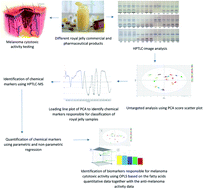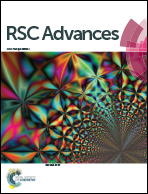Royal jelly fatty acids bioprofiling using TLC-MS and digital image analysis coupled with chemometrics and non-parametric regression for discovering efficient biomarkers against melanoma†
Abstract
A comprehensive approach of untargeted and targeted fatty acid bioprofiling of different royal jelly commercial and pharmaceutical products based on HPTLC-image analysis and melanoma cytotoxic activity together with chemometric analysis was applied in this study for discovering efficient biomarkers. Principal component analysis based on HPTLC-image analysis fingerprints of fatty acid loading plots were used to determine the chemical markers responsible for classification of royal jelly samples into fresh and lyophilized ones. These markers were identified using the HPTLC-MS technique as 8-hydroxyoctanoic acid, 3,10-dihydroxydecanoic acid, 10-hydroxy-2-decenoic acid, decanedioic acid and 10-hydroxydecanoic acid. These discriminating markers were quantified via the HPTLC-imaging technique for targeted profiling using two different methods: parametric and non-parametric regression. The non-parametric regression method exhibited superiority in terms of linearity, accuracy and precision. Biomarkers were determined from the 3D-loading plot of orthogonal projection to latent structures model based on the fatty acid quantitative data together with the melanoma cytotoxic activity data. 10-Hydroxy-2-decenoic acid showed the greatest reduction in melanoma cell viability followed by decanedioic acid then 8-hydroxyoctanoic acid. The present study is considered the first attempt to discriminate fresh and lyophilized royal jelly samples based on their holistic lipidomic profile to discover efficient fatty acid reducing melanoma cell viability.



 Please wait while we load your content...
Please wait while we load your content...